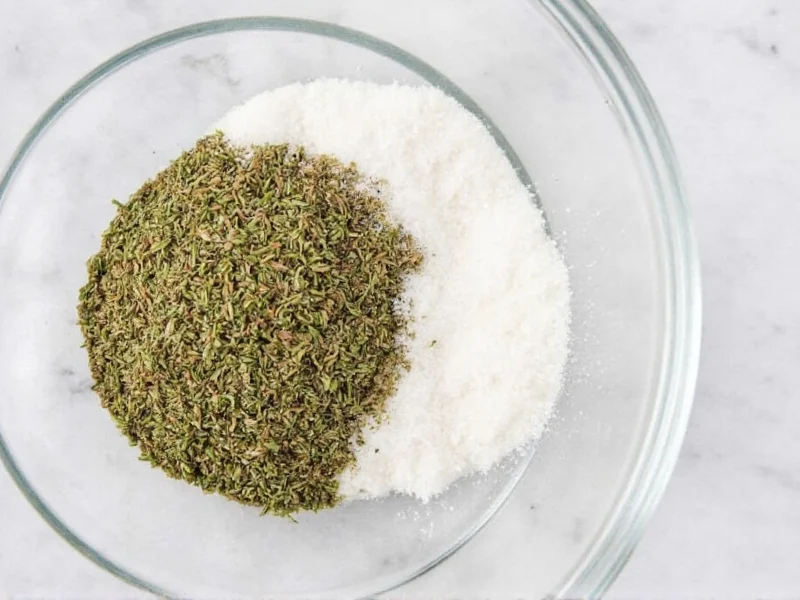1/4 teaspoon of dried thyme equals 3/4 teaspoon of fresh thyme. This 1:3 conversion ratio accounts for dried herbs' concentrated flavor compared to their fresh counterparts.
Understanding herb conversions is essential for consistent cooking results. When a recipe calls for dried thyme but you only have fresh (or vice versa), knowing the proper substitution ratio prevents flavor imbalances in your dishes. The standard conversion for most dried to fresh herbs follows a simple rule: 1 part dried herb equals 3 parts fresh herb.
Why Dried and Fresh Herbs Require Different Measurements
Drying concentrates herbs' essential oils and flavors while removing moisture. Fresh thyme contains approximately 85% water, which evaporates during the drying process. This concentration means dried thyme delivers more intense flavor in a smaller volume. Using equal measurements would result in overpowering dried herb flavors or weak fresh herb presence.
Thyme-Specific Conversion Guidelines
Thyme follows the general herb conversion rule but has some unique characteristics:
| Dried Thyme | Fresh Thyme | Best For |
|---|---|---|
| 1/8 tsp | 3/8 tsp | Delicate sauces and dressings|
| 1/4 tsp | 3/4 tsp | Standard recipe substitutions|
| 1/2 tsp | 1 1/2 tsp | Hearty stews and roasts|
| 1 tsp | 1 Tbsp | Long-cooking dishes
Practical Measurement Tips for Home Cooks
Accurate herb measurement significantly impacts your cooking results. Consider these practical tips:
- Use proper measuring tools - Dedicated measuring spoons provide more accuracy than flatware
- For fresh thyme - Strip leaves from stems before measuring; 1 sprig typically yields 1/2-1 teaspoon of leaves
- When substituting in recipes - Add fresh herbs later in cooking to preserve delicate flavors
- Adjust for freshness - Older dried herbs lose potency; increase quantity slightly if your dried thyme is over 6 months old
When to Modify the Standard Conversion Ratio
While the 1:3 ratio works for most situations, consider these adjustments:
- Long-cooking dishes (stews, braises) - Use slightly less fresh thyme (2:1 ratio) as flavors concentrate during cooking
- Delicate dishes (fish, salads) - Reduce fresh thyme by 25% to prevent overpowering subtle flavors
- Older dried herbs - Increase dried quantity by 25% if your dried thyme has lost potency
- Personal preference - Adjust to taste after initial conversion; some palates detect thyme's bitterness more strongly
Common Thyme Substitution Mistakes to Avoid
Many home cooks make these errors when converting between dried and fresh thyme:
- Using equal measurements without conversion
- Measuring fresh thyme with stems included
- Adding fresh thyme too early in cooking, causing flavor loss
- Not accounting for dried herb age and potency loss
- Substituting without considering the dish's cooking time
Storing Herbs for Maximum Potency
Proper storage affects your conversion accuracy:
- Dried thyme - Store in airtight containers away from light and heat; maintains potency for 1-2 years
- Fresh thyme - Wrap in damp paper towel and store in vegetable drawer; use within 1-2 weeks for best flavor
- Freezing fresh thyme - Preserves flavor better than drying; use 1:1 ratio with fresh thyme when frozen
Testing Your Herb Conversions
The best way to verify your thyme substitutions is through taste testing. When converting recipes:
- Start with the standard 1:3 ratio
- Add half the converted amount initially
- Taste after 10-15 minutes of cooking
- Adjust incrementally until desired flavor is achieved
Remember that individual palates vary, and regional thyme varieties differ in intensity. Mediterranean thyme tends to be more potent than some domestic varieties, which may require slight adjustments to the standard dried thyme to fresh conversion.
Frequently Asked Questions
Can I substitute dried thyme for fresh in a 1:1 ratio?
No, using a 1:1 ratio would make your dish too strong with dried thyme. The proper conversion is 1 part dried thyme to 3 parts fresh thyme. For 1/4 tsp dried thyme, use 3/4 tsp fresh thyme instead.
How do I measure fresh thyme accurately?
Strip leaves from stems first, then lightly pack into measuring spoons. One sprig of fresh thyme typically yields about 1/2-1 teaspoon of leaves. For precise measurement, use a kitchen scale (1 teaspoon fresh thyme weighs approximately 0.5 grams).
Does the conversion differ for lemon thyme or other thyme varieties?
Most thyme varieties follow the standard 1:3 conversion ratio. However, lemon thyme has a more delicate flavor profile, so you might use a 1:2.5 ratio instead. Always taste as you go when working with specialty thyme varieties.
Can I use thyme paste as a substitute for dried or fresh thyme?
Yes, thyme paste typically has a 1:1.5 ratio compared to fresh thyme. For 1/4 tsp dried thyme (which equals 3/4 tsp fresh), use approximately 1/2 tsp thyme paste. Adjust based on the paste's concentration and your taste preferences.
How does cooking time affect thyme substitution?
Longer cooking times concentrate flavors, so for dishes simmering over 2 hours, reduce fresh thyme by 25% from the standard conversion. For quick-cooking dishes like sautés, use the full 1:3 ratio as flavors don't have time to concentrate.











 浙公网安备
33010002000092号
浙公网安备
33010002000092号 浙B2-20120091-4
浙B2-20120091-4